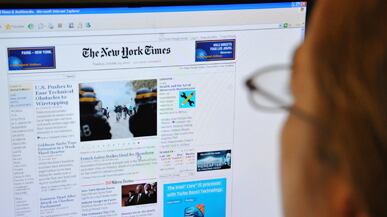The New York Times has put a price tag on its journalism, or at least some of it: $15 every four weeks.
That’s how much it will cost you to keep reading the Times online after you’ve clicked on 20 articles a month. Unless you’re already a home subscriber, the paywall will drop with a thud.

The long-anticipated move will begin in the United States and around the world on Mar. 28, but the Canadians will be guinea pigs. The paywall takes effect Thursday north of the border so the Times Co. can iron out any kinks.
ADVERTISEMENT
The company is trying to strike a delicate balance here: grant enough access to nonsubscribers so that nytimes.com remains part of the conversation—and traffic doesn’t plummet—while also telling them the free ride is over.
Ah, but there’s a back door: you can still access a truckload of Times content by clicking on links through Facebook, Twitter, blogs, Google, and other search engines (not to mention through The Daily Beast). The announcement says cryptically that there will be a “daily limit” on such access for “some search engines.”
Still, that’s a pretty wide-open door. On the plus side, it keeps nytimes.com plugged in to the conversation that swirls every day on social-media sites and well-read blogs. On the downside, it cuts into potential revenue if lots of people decide they’ll just Google and tweet and cheat-sheet their way to the Times stories and video they want without having to reach for the checkbook. (Don’t they have a responsibility to support the journalism they enjoy? I’d say yes, as a card-carrying media type, but the Net has spawned a strong information-wants-to-be-free ethos.)
Oh, and another thing: even the freeloaders will still be able to access the Times home page and section fronts. So this modified, limited paywall really affects only those who want to drill deeper into Times content.
Most newspaper companies are rooting for the Times to succeed so they can jump on the digital subscription bandwagon. With a few exceptions, such as The Wall Street Journal, they have been giving the entire paper away online, which of course depresses print circulation, and the Web ads it generates are worth only a fraction of plain old newspaper advertisements.
So if you want unlimited grazing rights for Times content online, you now have to fork over 195 bucks a year; that’s for the basic website and access on BlackBerry, iPhones or other smartphones. The cost rises to $260 if you want website and iPad access, and $455 for every form of digital access.
Some industry analysts say the Times went too far. “Pricing is absurdly high,” says blogger Steve Outing. “Yes, the New York Times is a great news organization producing the best journalism in the world. But faced with those fees when there are so many other quality news websites a click away, a small percentage of nytimes.com visitors will pay.”
Newsonomics writer Ken Doctor says the Times knows that only 1 to 3 percent of its users cough up the cash. “It’s going to be an uphill battle to get nonprint people to pay a minimum of $195 a year for something that was free, and it eschews conventional wisdom that $9.95 a month is a consumer limit on many digital items,” he writes.
How big a deal is this? Enough that company chairman Arthur Sulzberger Jr. is calling it one of the most significant days in the Times’s 159-year history: “Our decision to begin charging for digital access will result in another source of revenue, strengthening our ability to continue to invest in the journalism and digital innovation on which our readers have come to depend.”
The Times is gambling that there are enough news junkies out there willing to pay for their fix and not just surf away to The Washington Post, L.A. Times, Huffington Post, or a thousand other websites. Given the Times’s affluent readership, that gamble may pay off in a way that could be beyond the reach of other metropolitan dailies—unless we all become accustomed to the notion that someone has to pay for good journalism.
Howard Kurtz is The Daily Beast's Washington bureau chief. He also hosts CNN's weekly media program Reliable Sources on Sundays at 11 a.m. ET. The longtime media reporter and columnist for The Washington Post, Kurtz is the author of five books.






